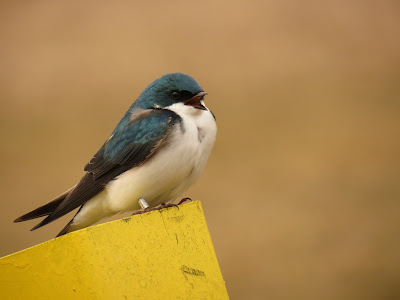Despite the forecast for freezing rain and snow on Thursday, spring has been gathering pace very quickly in the past few days, with birds pouring in and rapidly setting up territories. Most of the many nest boxes in the University of Guelph Arboretum now have a pair of either Eastern Bluebirds or Tree Swallows defending them, despite both species having only arrived in the past couple days. Tree Swallows can get very tame when nesting near people, and this bird allowed me to get some excellent shots:
Notice the band on its leg - a lot of the birds nesting or wintering in the Arboretum are banded.
A whole slew of other birds have just arrived as well, including Chipping Sparrows, Yellow-bellied Sapsuckers, Eastern Meadowlarks and a variety of other landbirds, as well as a diverse array of ducks. The highlight in the latter category was a Long-tailed Duck (very rare in Guelph) and Red-breasted Merganser (uncommon in Guelph) at some local ponds.
From left to right: Male Red-breasted Merganser, Female Common Merganser, Male Long-tailed Duck
Mammals have also been taking advantage of the warm weather. Groundhogs are now obvious lying on lawns around the university campus, although this guy was in somewhat more natural habitat in the Arboretum.
I've come across several Red Squirrels hanging out in nest boxes. Red Squirrels are very big nest predators, eating both eggs and chicks (and may be the biggest threat to bird nests in many areas), but none of the nest boxes should have eggs yet and these squirrels are presumably looking for a place to build their own nest.
I spent most of this evening with Josh Vandermeulen and some other friends from the University of Guelph Wildlife Club looking for amphibians out and about in the warm temperatures and rain. The rain made photography difficult but we certainly weren't disappointed, finding eleven species of amphibians as well as one reptile.
That one reptile was the most surprising find overall - this very early red-bellied snake curled up under a rock.
This was actually the first herp (reptile or amphibian) we found all night.
As the night grew darker both frogs and salamanders became increasingly common.
The ubiquitous Green Frog was the most frequently seen species. Unlike most of the amphibians seen, Green Frogs are not restricted to breeding in temporary pools in the spring, likely one of the reasons they are so widespread.
Other frog species seen included many Spring Peepers, one Northern Leopard Frog (pictured), an early Grey Tree Frog and several Wood Frogs (with more heard). Chorus frogs were heard calling but not seen.
Salamanders were also on the move. A few Red-spotted Newts were swimming in one of the vernal pools, and a few adults and a single red eft (the juvenile form of this species) were crossing the road. We also found a number of Red-backed Salamanders under rocks and logs. Red-backed Salamanders are fairly sedentary, not even returning to water to lay eggs, and so are not seen crossing roads and paths as much as one would expect from such an exceedingly abundant creature.
The Ambystoma salamanders (Yellow-spotted and Blue-spotted in this case) are very mobile on the other hand. These large species migrate as far as several kilometres each spring to a very specific vernal pool (a pond forming each spring but drying up in the summer) to breed.
We saw at least twenty of each of these species, many quite distant from the nearest pond.
The last salamander species is also the rarest we saw - the tiny Four-toed Salamander. This tiny guy was walking across the path, maybe heading to the boggy area where it will breed. Like the Red-backed Salamanders, this species does not have lungs and must absorb all of its oxygen from its surroundings.
Thanks Josh for inviting us along for a great night of herping! I'm sure he will put up some more pictures on his blog at some point.












I am in love with your picture of the yellow-spotted! Keep up the blogging :)
ReplyDeleteThanks, me too. They usually look like they're smiling but this guy just looks determined to get where he's going.
Delete